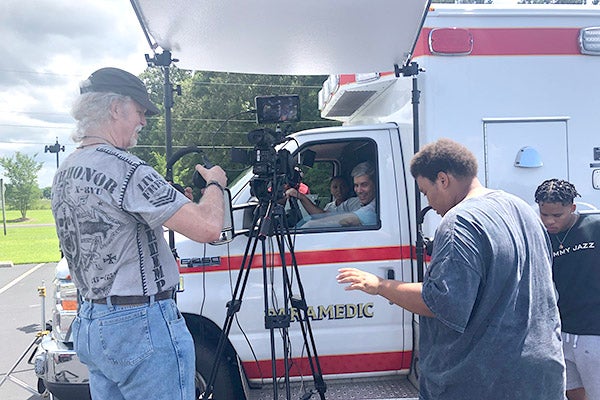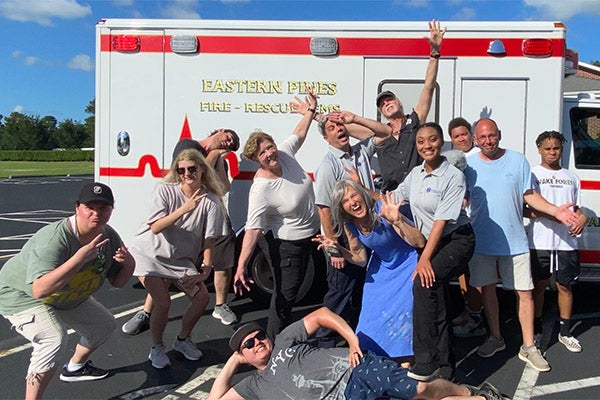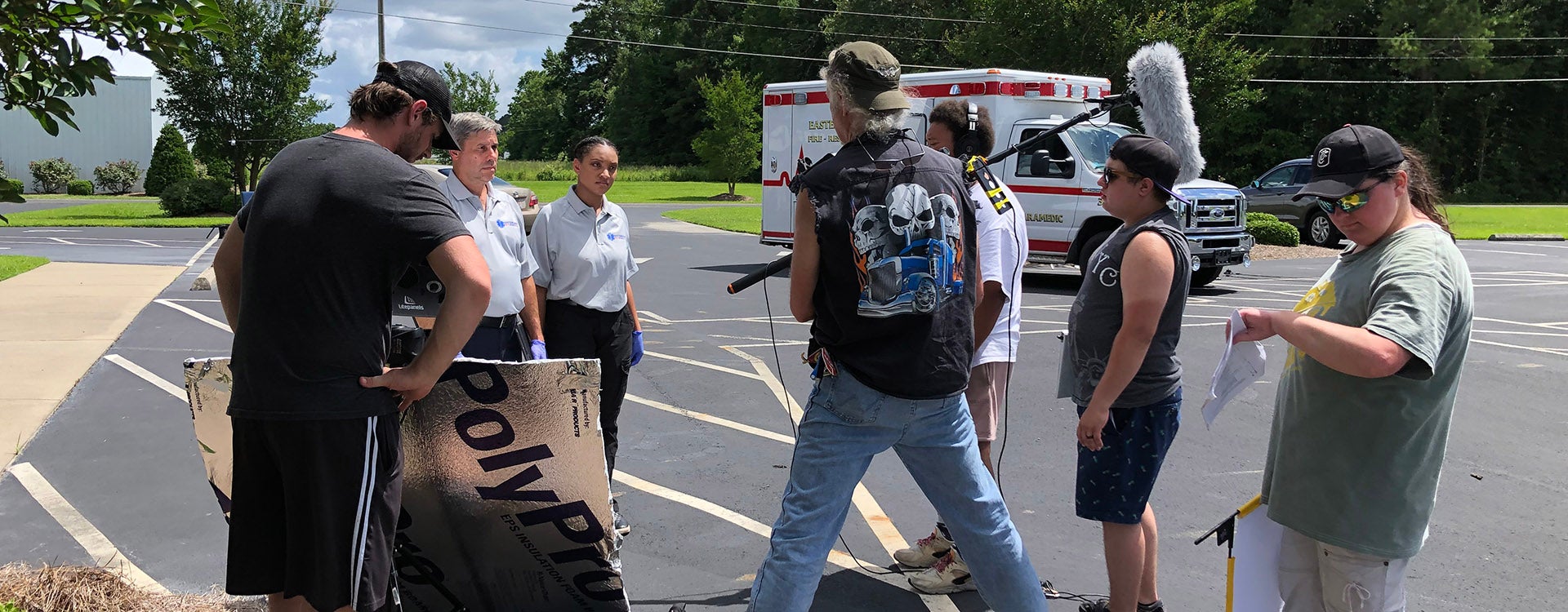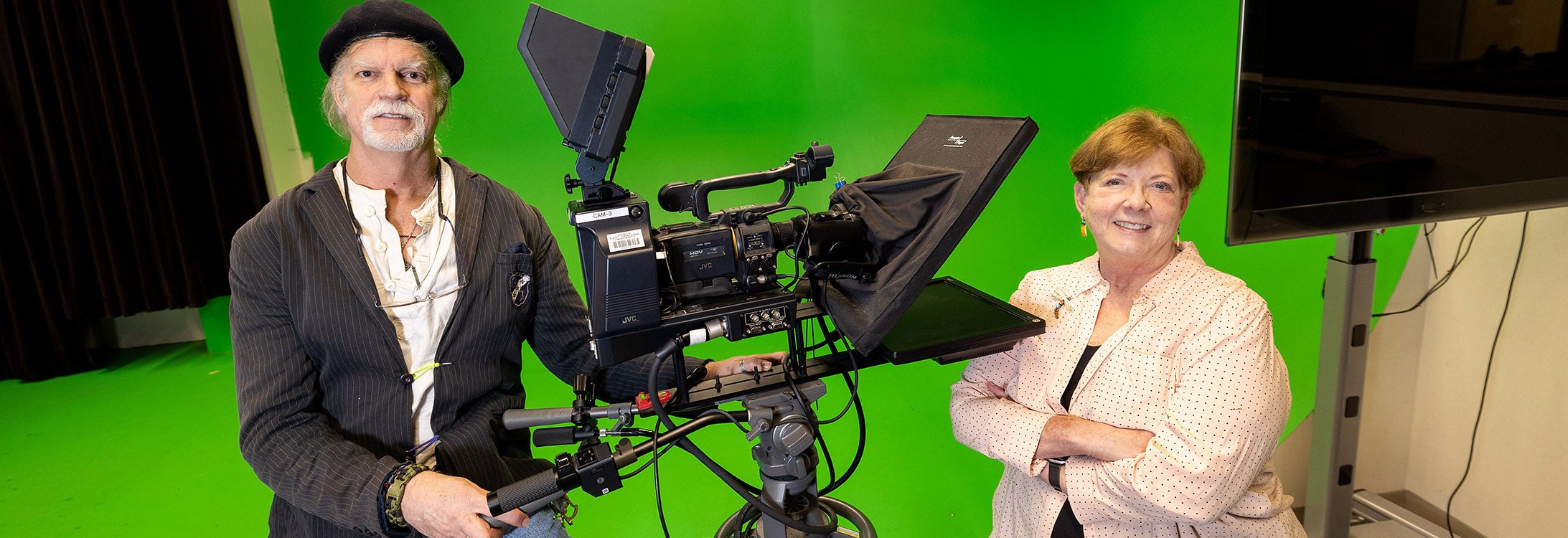SERVICE FILM
Occupational therapy professor enlists ECU filmmakers for public safety service project
What happens when a left-brained clinical researcher, a right-brained film production professor and a crew of East Carolina University students and alumni work together on the issue of older driver safety?
Literally movie magic.
In 2017, Anne Dickerson, a professor of occupational therapy at the College of Allied Health Sciences, was under a four-and-a-half-year contract with the federal National Highway Traffic Safety Administration to create an outreach and education program about driving safety. Dickerson wrote the grant request and routed it through the North Carolina Governor’s Highway Safety Program, to support one of the scheme’s pillars — older driver safety.
“What I wanted to do is educate physicians and law enforcement to send people who are medically at risk to be reviewed by the Medical Review Board in North Carolina,” Dickerson said. According to the North Carolina Department of Transportation, at-risk drivers are those who demonstrate health conditions like poor vision, slow reaction times, a history of losing consciousness and seizures, which could be coupled with age, but “advanced age alone cannot be the sole reason for a medical evaluation.”
The trouble, Dickerson soon found, is that North Carolina had only five — five — people qualified to evaluate drivers who were reported to be at risk, with none east of Raleigh. Dickerson quickly found a partner at ECU Health, then known as Vidant Health, who was willing to take the training and certification necessary to be an evaluator. Since 2018, the partnership has completed more than 500 at-risk driver evaluations in the Greenville area.
Dickerson said that the existing medical evaluation process is ponderous, not intuitive and subject to abuse. Anyone in the public can report any other driver as being medically unsound behind the wheel and a state agency then has to decide if the complaint is legitimate. If so, the reported driver is then provided an 11-page set of forms that must be signed by a certified medical professional to be allowed back on the road.
“It is very cumbersome. You can’t electronically send it; you have to fax it or send it in the mail,” Dickerson said. “It’s crazy.”
Dickerson found herself caught in a conundrum — there was an obvious problem with older drivers who might present a danger on the road, but the process for adjudicating a driver’s fitness was an impossible labyrinth. To make matters worse, most law enforcement and first responders — those who often have the most contact with questionably qualified drivers — were clueless about the process, or even that one exists, Dickerson said.
The North Carolina Highway Patrol used a form. It was vague, but it worked, Dickerson said. She partnered with a state trooper to overhaul the form which was approved and integrated into their system within a year.
“The form is really nice because it has a section that reports what they observe,” Dickerson said “They’re not diagnosing anybody, but it’s what they observed: Do they seem like disheveled? Are they confused? If law enforcement stopped somebody, or if they were in a crash, if they think there’s a medical condition, they’ll fill out this form.”
The challenge, Dickerson found was twofold — law enforcement and first responders first needed to know that there is a process for reporting suspected unsound drivers, and then empower and encourage those first responders to use it.
The film
Dickerson thought a video would be the most engaging way to educate those with the most direct contact with potentially unsound drivers, so she reached out to ECU’s School of Art and Design.
Erick Yates Green, an associate professor of film and video production at ECU, was intrigued by Dickerson’s proposal. She had money to fund a production and he had the background and skill to pull off a high-quality film and plenty of students and alumni to work on his crew.
“I asked ‘what if we use an entertainment angle? What if we tell a story instead of creating a PowerPoint?’” Green recalled. Dickerson was sold. After some negotiations with the grant funders, and the development of scripts and filming timelines, production began in the spring of 2021 with a crew of current and recently graduated ECU film students.

Green, left, sets up to film a sequence for the “Making the Call” video.

Green and Dickerson with the student and alumni production crew.
“What we aspired to do with this project was to fulfill our client’s needs, create a well-produced piece of entertainment and to let the students enjoy a professional on-the-job experience,” Green said.
Production of the film, “Making the Call, EMS Identifying Medically-at-Risk Drivers,” came together quickly. Volunteers from the Eastern Pines Fire-Rescue-EMS station in Pitt County signed on to support the 10-minute video’s production.
The story revolves around two EMS workers — an older supervisor close to retirement and a young new employee who tries to incorporate the at-risk driver reporting form into her agency’s operations. The senior first responder is convinced of the value of the reporting form after assisting an older driver who was injured in a crash, visibly confused and likely a danger behind the wheel.
Dickerson hopes she stressed through the film that first responders are helping to identify those at risk to themselves and others rather than being bad guys who are limiting the dwindling freedoms that many older adults feel slipping away with age.
In the script development phase, Dickerson reached out to a senior EMS official who shot the idea for the film full of holes, saying that it was the responsibility of doctors, not first responders, to identify and evaluate at-risk drivers. His father had been stopped while driving and was referred for medical evaluation, ultimately requiring the intervention of a lawyer to prove that the EMS official’s father had been prescribed the wrong medication and that he wasn’t a danger on the road.
You just proved my point, Dickerson responded, and conveyed that anecdote to Green, which helped to mold the temperament of the film’s senior EMS character.
“It’s not about taking away the keys, it’s about identifying an issue. It might be that they’re on the wrong medicine,” Dickerson said.
At first, Dickerson was unsure about the production process, having worked on a handful of video projects in the past, which were more informational in tone and production.
“I’ve not done this and felt that maybe this is a little too artsy,” Dickerson said. “But I would tell myself, ‘Well, you’re not the expert. Trust the process.’”
Lea Meeks, a 2017 graduate of the ECU occupational therapy (OT) program who works at UNC Lenior Health Care center in Kinston, has also been a paramedic since 2016. When Dickerson asked her to serve as a technical advisor for the project she jumped at the opportunity.
Dickerson was Meeks’ advisor for her master’s thesis and employed Meeks as an assistant working on research involving older and medically at-risk drivers while she was still in OT school. Being an EMS worker and a certified occupational therapist who understood Dickerson’s educational goals with the film made Meeks an easy fit.
“I reviewed the script and provided feedback. I helped coordinate getting the ambulance, uniforms and station for the filming and then I was there during the filming as well,” Meeks said. Her relationship with the Eastern Pines EMS station, having served as the EMS chief among other leadership roles, helped open doors for disruptions that several days of filming would incur.
“I’d say it was 80 to 85% realistic on the EMS side and from the OT perspective it’s definitely realistic. I thought it turned out great,” Meeks said.
Meeks agreed that as an emergency medical worker, having another form to fill out complicates and already stressful and taxing job.
“If it’s one or two clicks before you close a chart, that would be something simple to do. In EMS we see terrible things all the time. A couple of years ago, an elderly driver was going the wrong way and killed somebody. If we understand the reason why the forms need to be filled out, rather than just another requirement, it will be more well received,” Meeks said.
Training for students
One thing that attracted Green to the project was the possibility of providing his film students a real production experience, including paying them, which rarely happens with student-centered film projects.

Green and Dickerson have fun with the student and alumni production crew and actors during production of the film “Making the Call.”
While Green directed and was the cinematographer, the student and alumni crew members assumed all the other production jobs: audio, lighting and drone piloting for aerial videography. The hands-on experience of a real, working film set was invaluable as a teaching tool.
“Parents ask me these questions at open house, they pull me aside and say, ‘Can they get a job?’ And I tell them, yeah. It’s going to be tough to be Spielberg. I’m not Spielberg,” Green said. “So how do you make a career in video production? This is a really good example.”
A recent ECU film graduate, John Long from Charlotte, edited the film, which Green took pride in — having a Pirate alumnus play such a critical role in the film’s final cut, and being able to pay him for his efforts.
“It felt really cool to be part of a team that was made up largely of ECU students and alumni,” Long said. “I commend Erick and professors like him that seek out paid opportunities for students. It’s the best way to gain experience.”
Impact on community
The educational experiences resulting from the film’s production weren’t limited to the art and design students. The film is one spoke on a complex wheel of helping older drivers to remain licensed motorists, and as self-reliant, for as long as possible.
A select group of Dickerson’s students are collecting data on at-risk drivers, based on the results from the Greenville-based evaluator’s reports as well as control group evaluations of “normal” drivers. Dickerson hopes to have several papers to emerge from the study, authored in part by her occupational therapy students, relating to motor-processing skills needed for driving and predictive models based on driving simulators.
Don Shue, an operations supervisor for the Mecklenburg EMS, was first introduced to the idea and promotion of the reporting form when Dickerson was invited to present at a community organization focused on reducing traffic injuries and fatalities. Intrigued by the promise of the reporting form to help EMS improve traffic safety, Shue reached out to Dickerson to find a way to partner on the initiative.
“While she was discussing the form I was thinking about the times that I’ve been to situations where we encounter a patient who is having some type of situation but law enforcement wasn’t dispatched because we get a call that a person has been sitting in front of a drug store for an hour in their car,” Shue remembered. “We end up transporting the person because they can’t remember how to get home.”
Mecklenburg EMS is evaluating the revised NCHP form and working with state agencies to figure out how to incorporate the reporting capacity into everyday operations, but Shue is hopeful that a simple tool like a form could improve safety for all motorists.
“We’re not out there crusading to take (seniors’) driver licenses away but I’ve seen, a number of times, an elderly driver who shouldn’t have been on the road. Because of their medical or physical conditions they were not able to safely drive anymore and end up driving through the front of a building or the wrong way on the interstate, so I think this would be a very valuable tool,” Shue said.
Dickerson said that she has been totally convinced about the importance of narrative to convey complex, fact-based information — in and out of the classroom.
“When I teach students, what they remember are the stories. You can give them all the facts, but if you make them feel with a story – that’s what this film has.”

Green and his ECU student and alumni production crew film a scene of the film “Making the Call.”
